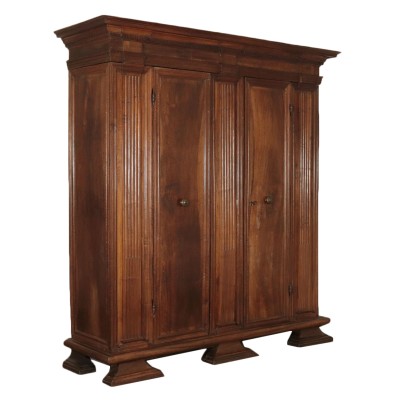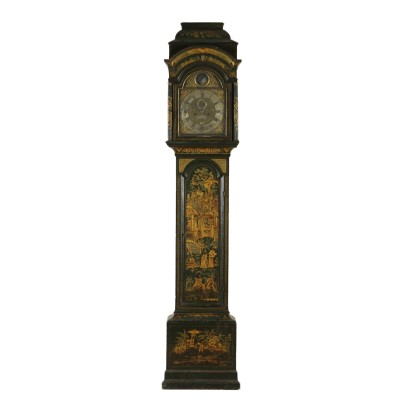Walnut Wardrobe Italy 17th Century
Features
Style: Renaissance (1460-1630)
Age: 17th Century / 1601 - 1700
Origin: Italy
Main essence: Walnut
Description
Important antique wardrobe with three big double bracket feet. It has three cabled uprights and two doors with bronze knobs, made with one framed walnut board. The upper part is decorated with several orders of frames and a notched frame.
Product Condition:
Fair condition. Wear consistent with age and use.
Dimensions (cm):
Height: 278
Width: 264
Depth: 77,5
With certificate of authenticity
Additional Information
Style: Renaissance (1460-1630)
With the Renaissance, furniture took on architectural forms, perfect proportions, adorned with rationally arranged decorations, taken from Greco-Roman iconography.Supports and feet carved in acanthus leaf or lion's paw appear at least from the early 1560s.
Next to parallelepiped chests appear others in the shape of a classic sarcophagus, with surfaces marked by ornamental metrics rigidly regulated within pilasters and frames.
The novelty of the sculptural intaglio decoration deduced from archaeological remains triumphs, stylistic elements decoded and reworked in different compositional harmonies arranged in alternating plays of dentils, ovules, volutes, acanthus-shaped spirals, loricatures, dressings, candelabras and grotesques, and the whole relives pantheon of pagan mythology, to historize in particular chests, which the initial function of container of the wedding dowry takes over the new instance of real parade furniture.
It should be remembered that the furniture displayed was generally richly embellished with gold leaf gilding.
In the first decades of the sixteenth century, the use of the Carthusian inlay definitively declined, although even in the Renaissance this technique had great renown, just think of the activity of the Tasso workshop in Florence.
Find out more about the Renaissance style with our insights:
Renaissance style
A pair of candle holders between Renaissance and Baroque
FineArt: the Renaissance
FineArt: Renaissance golden Cassina, Belloni family – Venice, 16th century
The dictionary of antiques - Savonarola
Age: 17th Century / 1601 - 1700
17th Century / 1601 - 1700Main essence: Walnut
Walnut wood comes from the plant whose botanical name is juglans regia , probably originally from the East but very common in Europe. Light or dark brown in color, it is a hard wood with a beautiful grain, widely used in antique furniture. It was the main essence in Italy throughout the Renaissance and later had a good diffusion in Europe, especially in England, until the advent of mahogany. It was used for solid wood furniture and sometimes carvings and inlays, its only big limitation is that it suffers a lot from woodworm. In France it was widely used more than anything else in the provinces. In the second half of the eighteenth century its use decreased significantly because mahogany and other exotic woods were preferred. Alternative proposals


































